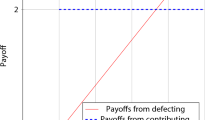Abstract
We consider a model of influence over a network with finite-horizon opinion dynamics. The network consists of agents that update their opinions via a trust structure as in the DeGroot dynamics. The model considers two potential external influencers that have fixed and opposite opinions. They aim to maximally impact the aggregate state of opinions at the end of the finite horizon by targeting with precision one agent in one specific time period. In the case of only one influencer, we characterize optimal targets on the basis of two features: shift and amplification. Also, conditions are provided under which a specific target is optimal: the maximum-amplification target. In the case of two influencers, we focus on the existence and characterization of pure strategy equilibria in the corresponding two-person strategic zero-sum game. Roughly speaking, if the initial opinions are not too much in favour of either influencer, the influencers’ equilibrium behaviour is also driven by the amplification of targets.

Similar content being viewed by others
Data Availability
No data associated in the manuscript.
Notes
Throughout this paper, we adopt the convention that \(W^0=I\), where I denotes the \(n \times n\) identity matrix.
We denote the \(j^{\text {th}}\) unit vector of length n by \(\textbf{e}_j\), where \(\textbf{e}^k_j=1\) if \(k=j\) and \(\textbf{e}^k_j=0\) if \(k \ne j\).
We denote the all-ones vector of length n by \(\textbf{e}\).
References
Bimpikis K, Ozdaglar A, Yildiz E (2016) Competitive targeted advertising over networks. Oper Res 63(3):705–720
DeGroot MH (1974) Reaching a consensus. J Am Stat Assoc 69(345):118–121
del Pozo M, Manuel C, Gonzalez-Aranguena E, Owen G (2011) Centrality in directed social networks: a game theoretic approach. Social Netw 33(3):191–200
French JJ (1956) A formal theory of social power. Psychol Rev 63:181–194
Goyal S, Heidari H, Kearns M (2014) Competitive contagion in networks. Games Econ Behav 113:58–79
Grabisch M, Li F (2020) Anti-conformism in the threshold model of collective behavior. Dyn Games Appl 10:444–477
Grabisch M, Mandel A, Rusinowska A, Tanimura E (2018) Strategic influence in social networks. Math Oper Res 43(1):29–50
Grabisch M, Poindron A, Rusinowska A (2019) A model of anonymous influence with anti-conformist agents. J Econ Dyn Control 109:103773
Hunter D, Zaman T (2022) Optimizing opinions with stubborn agents. Oper Res 70(4):2119–2137
Husslage B, Borm P, Burg T, Hamers H, Lindelauf R (2015) Ranking terrorists in networks: a sensitivity analysis of al qaeda’s 9/11 attack. Social Netw 42:1–7
Lever C (2010) Strategic competitions over networks. PhD thesis, Stanford University, Stanford, CA
Nash J (1951) Non-cooperative games. Ann Math 54(2):286–295
Proskurnikov AV, Tempo R (2017) A tutorial on modeling and analysis of dynamic social network, part i. Ann Rev Control 43:65–79
Proskurnikov AV, Tempo R (2018) A tutorial on modeling and analysis of dynamic social network: part ii. Ann Rev Control 45:166–190
Russell M (2022) Foreign interference in eu democratic processes. Technical Report PE 729.271, Special Committee on Foreign Interference
Funding
Not applicable.
Author information
Authors and Affiliations
Contributions
All three authors contributed to the development of the paper and the underlying research.
Corresponding author
Ethics declarations
Conflict of interest
We have no competing interests to declare.
Ethical Approval
Not applicable.
Additional information
Publisher's Note
Springer Nature remains neutral with regard to jurisdictional claims in published maps and institutional affiliations.
Rights and permissions
Springer Nature or its licensor (e.g. a society or other partner) holds exclusive rights to this article under a publishing agreement with the author(s) or other rightsholder(s); author self-archiving of the accepted manuscript version of this article is solely governed by the terms of such publishing agreement and applicable law.
About this article
Cite this article
de Vos, W., Borm, P. & Hamers, H. Influencing Opinion Networks: Optimization and Games. Dyn Games Appl (2023). https://doi.org/10.1007/s13235-023-00543-6
Accepted:
Published:
DOI: https://doi.org/10.1007/s13235-023-00543-6




